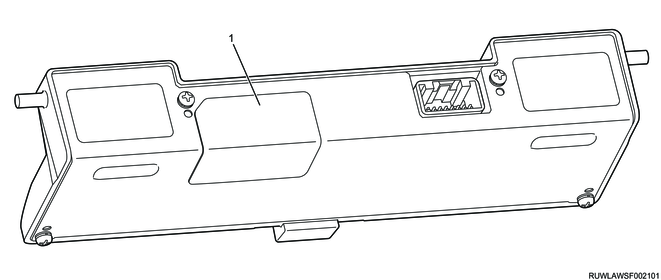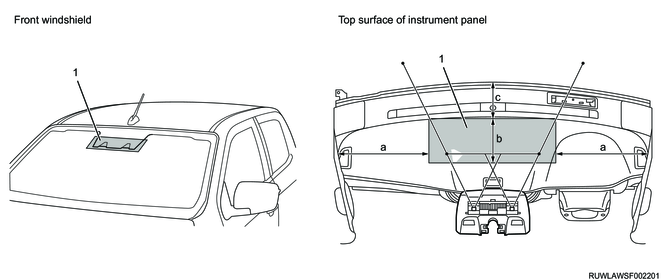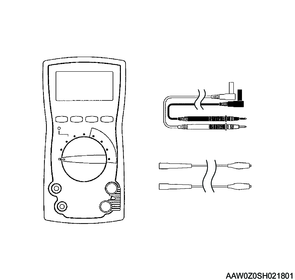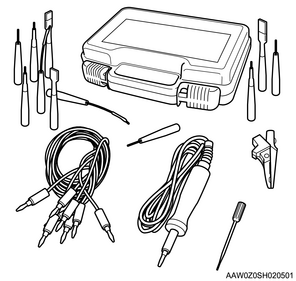1. Maintenance precautions of stereo camera system
1. Precautions for handling stereo camera
For the stereo camera system, the stereo camera is equipped. The system may not operate normally if the stereo camera is mishandled. Handle the stereo camera with care.
- Do not remove the stereo camera unnecessarily except when it is required during maintenance work.
- Do not subject the stereo camera to a strong impact.
- Do not change the stereo camera installation position.
- Do not change the surroundings the stereo camera.
- Do not touch the stereo camera lens.
- Do not attach a film, sticker, etc., on the stereo camera lens.
- Do not clean the stereo camera lens.
- Do not attach any liquid on the stereo camera.
- Do not use a smoke-type air freshener.
- When removing the stereo camera, cover the lens with plastic sheets, etc., to prevent dirt from adhering to the lens section.
- If the aluminum seal section of the stereo camera is damaged, replace the stereo camera with a new one.

Legend
- Aluminum seal section
2. Precautions for handling windshield
The system may not operate normally if the windshield is mishandled. Handle the windshield with care.
- Do not put stickers, etc., on the windshield in front of the stereo camera lens.
- Always keep the windshield clean.
- There should be no damage such as scratches and cracks on the windshield.
- Do not apply glass coating agent to the windshield.
- Do not use a windshield other than the specified.
- Wiping conditions of the wipers should be normal in order to keep the windshield always clean.
3. Stereo camera image blocking prohibited area
Installation position of the stereo camera is determined for the performance. Do not change the installation position. Also, the stereo camera will not operate correctly if there are obstacles within the imaging range of the stereo camera. Take care not to allow obstacles within the following range of the stereo camera and on the top surface of the instrument panel.

Legend
- Image blocking prohibited area
Range
a: about 380.0 mm { about 15.0 in }
b: about 200.0 mm { about 7.9 in }
c: about 120.0 mm { about 4.7 in }
4. Film, sticker, and accessory component handling
Do not attach a film, sticker, or any non-genuine Isuzu accessory components on the following places because the system may not work normally due to poor visibility of the stereo camera.
- Image blocking prohibited area
Do not attach any non-genuine Isuzu accessory components on the following places because the system may not work normally due to poor visibility of the stereo camera.
- Engine hood
- Radiator grille
- Front bumper
5. Stereo camera learning
If any of the following are met, the stereo camera learning must be performed. Refer to Stereo camera learning in the workshop manual.
- The windshield is replaced.
- The stereo camera is installed or removed.
- The stereo camera is replaced.
Note
- When the stereo camera is replaced with a new one, the DTC will be set unless the stereo camera learning is complete.
Refer to "9.Body, Cab, Accessories 9E.Instrumentation, Driver Info. stereo camera writing".
6. About steering angle sensor learning
If any of the following are met, the steering angle sensor learning must be performed. Refer to Steering angle sensor setting in the workshop manual.
- The steering angle sensor is replaced.
- The steering related parts are replaced.
Refer to "6.Steering 6Z.Steering Electrical Control steering angle sensor setting".
7. Using circuit test tools
Unless instructed in the diagnostic procedure, do not use a test lamp. When a probe connector is required in a diagnostic procedure, use connector test adapter kit (5-8840-2835-0).
8. Commercial electronic equipment
Aftermarket electronic equipment refers to commercially available electronic equipment installed to the vehicle after it has been shipped from the factory. Be careful, as such accessories are not taken into particular consideration at the vehicle design stage.
Aftermarket electronic equipment may cause malfunctions in the electronic control system, even if the equipment is properly installed. Aftermarket electronic equipment includes devices not connected to the electronic control system of the vehicle, such as mobile phones or radios. Therefore, when diagnosing electrical system problems, first check whether such aftermarket electronic equipment is installed. Remove it from the vehicle if installed. If the problem has not been resolved after removing the equipment, perform the diagnosis using the regular procedure.
Caution
- Make sure that both the power supply and ground of aftermarket electronic equipment are connected to a circuit that is not related to the circuits of the electronic control system.
9. Damage caused by electrostatic discharge
Because the electronic components used in the electronic control system are designed to operate at extremely low voltages, they can easily be damaged by electrostatic discharge, and some types of electronic components can be damaged by an electrostatic charge of 100 V or less, which cannot be felt by humans. (A voltage of 4,000 V is required for a person to be able to detect an electrostatic discharge.)
There are various ways a person can build up an electrostatic charge. The most common way to build up an electrostatic charge is through friction or induction. An example of when a person builds an electrostatic charge by friction is when they slide across the seat of the vehicle. A person wearing insulated shoes can build an electrostatic charge by induction if they momentarily touch the ground while standing near a highly charged object. A charge of the same polarity flows out, and with a highly opposing polarity, that person becomes charged. Because static electricity can be damaging, be extremely careful when handling or testing electronic components.
Caution
- To prevent damage caused by static electricity, do not touch the connector pins of the stereo camera or the electronic components soldered onto the circuit board of the stereo camera.
- To prevent damage caused by static electricity, do not open the packaging of a replacement part until the preparations for installation of the part are completed.
- To prevent damage caused by static electricity, connect the package to a properly working vehicle ground before removing the part from the package.
- To prevent damage caused by static electricity, touch a properly working ground before installing the part in such cases as when handling the part while sliding across a seat, when sitting down from a standing position, or while walking a certain distance.
10. Tools to be used
When measuring the voltage and resistance, make sure to correctly use the tools, such as the scan tool, connector test adapter kit (5-8840-2835-0), and digital multimeter [DMM] (5-8840-0285-3).
11. Digital multimeter (DMM)
Use the specified DMM (5-8840-0285-3) for diagnosing or repairing the stereo camera. Use of another DMM for diagnosing or repairing the stereo camera is not allowed.

12. Connector test adapter kit
Use the connector test adapter kit (5-8840-2835-0) when the diagnostic procedure requires inspection or detailed checking using a terminal. Use the appropriate adapter to prevent the terminal from being damaged.
